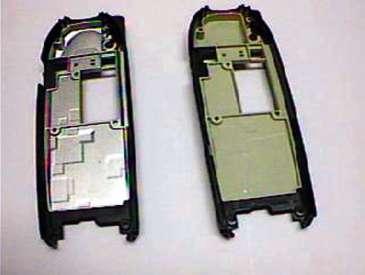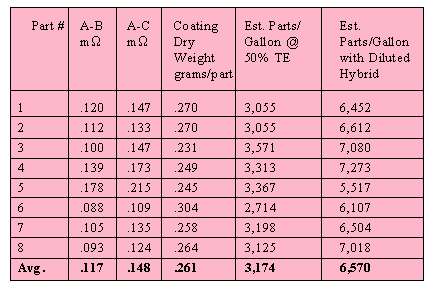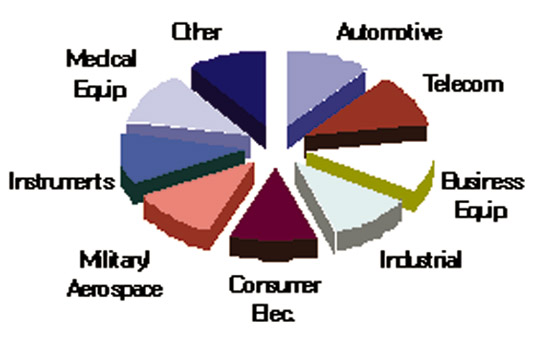5 Key Advancements in Conductive Paint TechnologyBy Neil Browes, Roy Bjorlin, Gary Shawhan Spraylat Corporation |
Introduction
Conductive coatings continue to be a useful problem solving tool for product designers and EMC engineers trying to achieve regulatory compliance. Conductive paint technology has grown steadily in market acceptance since the late 1980's, when the first viable copper paint product was introduced by Spraylat.
Since this time, 4-5 generations of conductive paint products have been introduced to the market - each product offering incremental improvements in coating performance while steadily improving the application process window. These advancements in paint technology have been driven, in part, by the increasing demands for EMC materials that can provide increased performance and coating quality at a lower application cost. They are also increasingly influenced by the transition from regional to global markets. Market globalization, in fact, has altered the OEM criteria for material selection. The necessity of knowing that a comparable result (from a given technology) is accessible at several alternative global sites has become a must to many manufacturers.
Conductive paint technology has become unique among other conductive coating technologies in its ability to address cost, performance and global infrastructure issues successfully. The following "5 Key Advancements" in conductive paints provide a glimpse at these important transitions that are incorporated into the new SOS Series of conductive paint products from Spraylat.
Advantage#1: Reduced Coating Thickness
There has been a remarkable transition in the ability of conductive paints to deliver a quality result while using less and less material on the part. Compared to even 3 or 4 years ago, the latest generation of conductive paints can be applied at thicknesses that are 2-4 times less compared to their predecessors.
Dry Film Thickness Ranges for Current Generation Paint Products
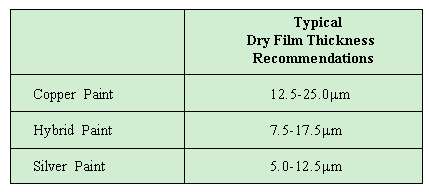
As shown in the following illustration, the reduction in recommended applied coating thickness (with SOS technology) to achieve reliable coating performance has been substantial. This is especially true in the case of copper paints where the improvement has been 2 or 4 times.
SOS Copper Paint ohms-per-square
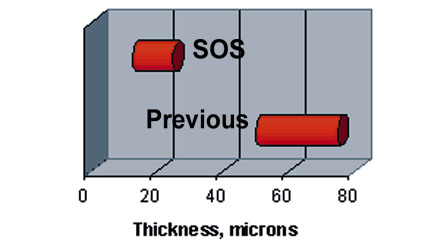
SOS Silver Paint Ohms-per-square
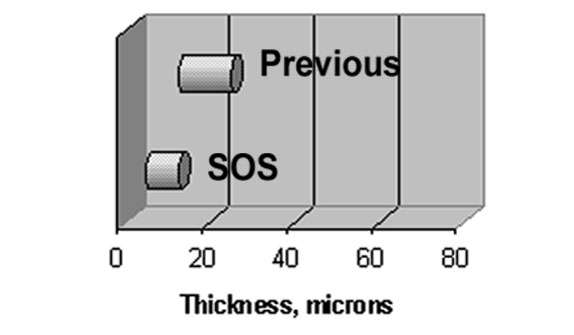
Advantage # 2: Improved Electrical Properties
The conductivity of today's conductive paint technology is far superior to earlier paint products. This improved performance is also readily achieved at the lower thicknesses noted above. As a consequence, the ability of today's conductive paints to address electrical performance specification requirements, with a wider process window, has definitely increased. This feature has added flexibility to conductive paints in their ability to satisfy a broader range of product applications in a cost-effective way.
Ohms-per-square resistivity values are used to identify the conductivity of a given coating at a certain location on a given part. Often used as a quality control test, ohms-per-square test results provide a good basis for the comparison of earlier generation conductive paint products and the latest conductive paint technology.
Ohms-per-Square Test Results Latest Generation Paints
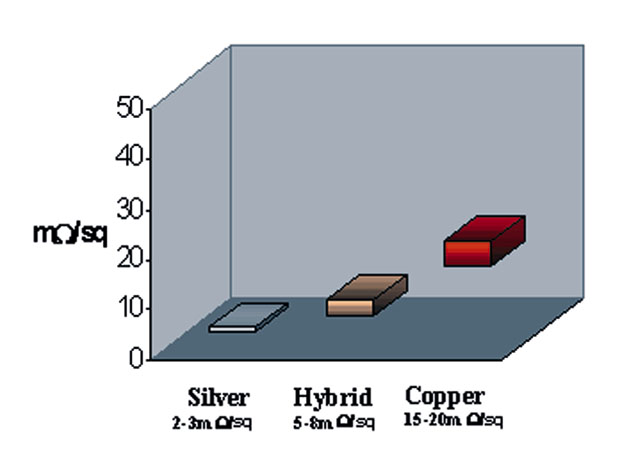
Ohms per Square Test Values
SOS copper paint technology has improved 3-4 times in its resistivity values as compared to the earlier generation products. When first introduced, these coatings produced ohms-per-square resistivity values of 90-100 milliohms/square. Mid-generation copper coatings provided resistivities of 50-60 milliohms/square. Recent advancements have taken this down to 15-20 milliohms/square. Most significant this improvement in conductivity is achieved at a 2-4 times reduction in coating thickness.
SOS silver paints have also improved in their electrical conductivity, producing very low resistivity values, even at extremely low coating thicknesses. The engineering involved in the formulation of these newer products provides for greater intimacy of the conductive media within the coating, even when very thin films are applied. Thus SOS silver paint coatings also provide improved resistivity values.
The increased electrical conductivity of these newer conductive paint products is also reflected in their improved point-to-point electrical performance. Today, conductive paints can provide comparable performance to selective plating, even on parts with more complex geometry. As a consequence, the ability of conductive paint coatings to achieve low point-to-point values across highly featured parts has been significantly improved. The following part is one example of a complex part where conductive paint is able to provide adequate point-to-point resistivity (vs. a 1ohm point-to-point specification) from corner-to-corner. Earlier generation conductive paint products could not have met this requirement.
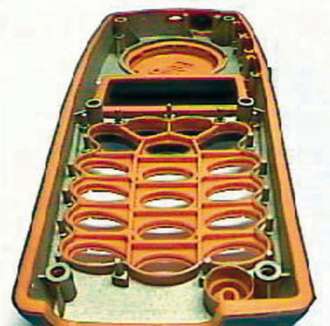
One additional advantage for conductive paints is the benefit of being able to customize the amount of material delivered to different featured areas on the part. This means that critical locations, such as ground connections, can selectively incorporate more material for performance reasons.
The shielding effectiveness of these latest conductive paint products from Spraylat is excellent and comparable or superior to alternative conductive coating technologies. Typical results, according to the ASTM D4935-89 Co-Axial Transmission Line test method, are shown in the table below. This test method is designed to test electrically thin materials like conductive coatings at frequencies between 30MHz and 1.5GHz.
ASTM D4935-89 Shielding Effectiveness Test Results, dB
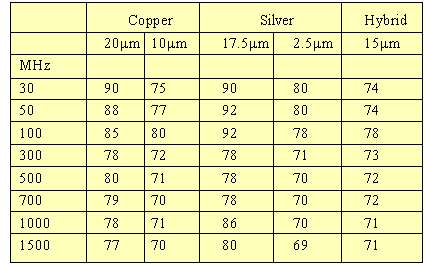
It is important to note (from the preceding table) the excellent shielding effectiveness achieved at "very low" dry film thicknesses. Copper coatings, based on SOS technology, provide more than 70db of shielding at only 10 microns film thickness. The new silver-based coatings provide 70 dB of shielding at only 2.5 microns underscoring their versatility as an EMI shielding solution.
Shielding effectiveness testing has also been performed on these conductive paint products at higher frequencies according to the MIL-STD 285 test method. This testing is performed using a shielded room with results reported at selected frequencies up to 10GHz. As shown in the following chart, conductive paints provide a consistently high degree of shielding effectiveness at all frequencies tested.
MIL STD 285 Shielding Effectiveness Test Results

Advantage # 3: Coating Adhesion/Cohesion and Film Durability
Conductive paints have always achieved good adhesion to a wide range of plastics. Over years of product development, however, paint adhesion has made some additional improvement while the solvents used in product formulation have become more substrate compatible. This latest generation of SOS solvent paint products is alcohol-based and offers low VOC's for improved environmental friendliness. When polycarbonate-based resins are involved and/or thin-wall moldings are being used for the enclosure manufacture, aggressive solvents contained in the paint can result in substrate crazing or cracking. The following illustration shows the advantages of these new products (right) as compared to an earlier generation conductive paint product employing MEK as the solvent (below).
ATTACK (l/handside) compared to SOS PAINT -No Attack (r/handside)
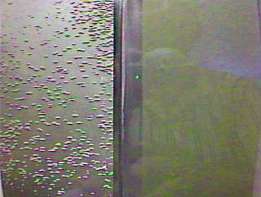
The common plastics processed with today's conductive paints include the resins shown in the following table. Special processes or products may be available for certain other resins or grades of plastics to achieve good adhesion for that particular material. These special processes or products are normally best discussed and validated individually with the material supplier.
Common Painted Plastics:
| ABS |
| ABS/PC or PC/ABS Blends |
| PC (Polycarbonate) |
| PS (Polystyrene) |
| PPO (Polyphenylene Oxide) |
| PEI (Polyetherimide) |
| Nylon |
Film cohesion, or "particle pick-off" was a traditional criticism of conductive paint coatings in the past. The latest paint products, however, has rewritten the rules regarding paint film integrity. Today, there is essentially no film cohesion issue associated with these newer products. Examining the tape test result, the comparison of the newer paint coating to earlier ones is clear. In addition, as shown the next illustration, these new coatings can consistently pass the ASTM D3359-95a Cross-Hatch Adhesion Test. This was not the case with earlier product formulations.
TAPE TEST
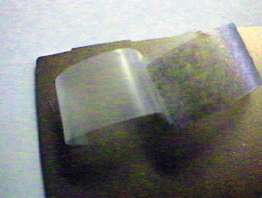
Cross Hatch Adhesion Test
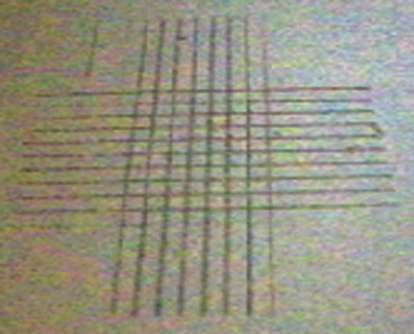
Another area of major improvement in paint coating properties has been film durability. In general, there has always been a desire to achieve a high level of coating integrity, accommodating various assembly and disassembly procedures without affecting the properties of the conductive film. In this regard, the present generation of conductive paints offers several orders of magnitude improvement in coating durability. The following graph shows the relative improvement in coating properties according to the RCA Abrader test method. Results for both of the SOS conductive paint coatings exceeded 500 cycles by a significant number of cycles. Earlier generation copper paints typically produced values below 25 cycles. Silver paint coatings, which had been traditionally soft and abradable, would only provide about 10 abrasion cycles before failure.
RCA Abrader Test
COPPER=RED.........SILVER=GREY
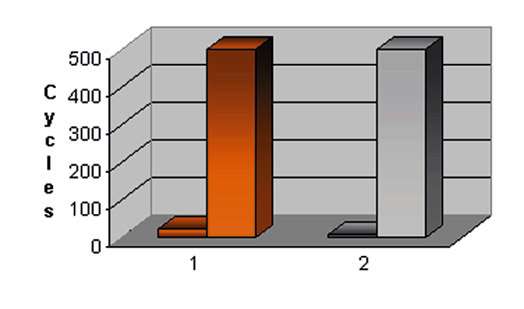
Advantage # 4: Increased Productivity
Productivity is an essential element in determining the overall cost for using any process. Spraylat's SOS Series products have made some important strides forward in improving their productivity and, as a consequence, reducing their use cost. In a spray application the issue of transfer efficiency (paint delivered onto the part expressed as a % of the paint used) is always a basic element of cost concern.
Transfer efficiency is affected by several key variables including the part complexity, the type of equipment used (hand vs. robotic spray), gun settings, spray technique or programming in the case of robotics and volume throughput.
The overall productivity achievable from a given coating process is driven by the ability of the technology to adapt to these variables. This is often referred to as the process window for the product or technology. The latest generation of conductive paint products has established a much wider process window within which applicators can achieve a cost-effective result. The key features of these products that have established a wider process window include:
